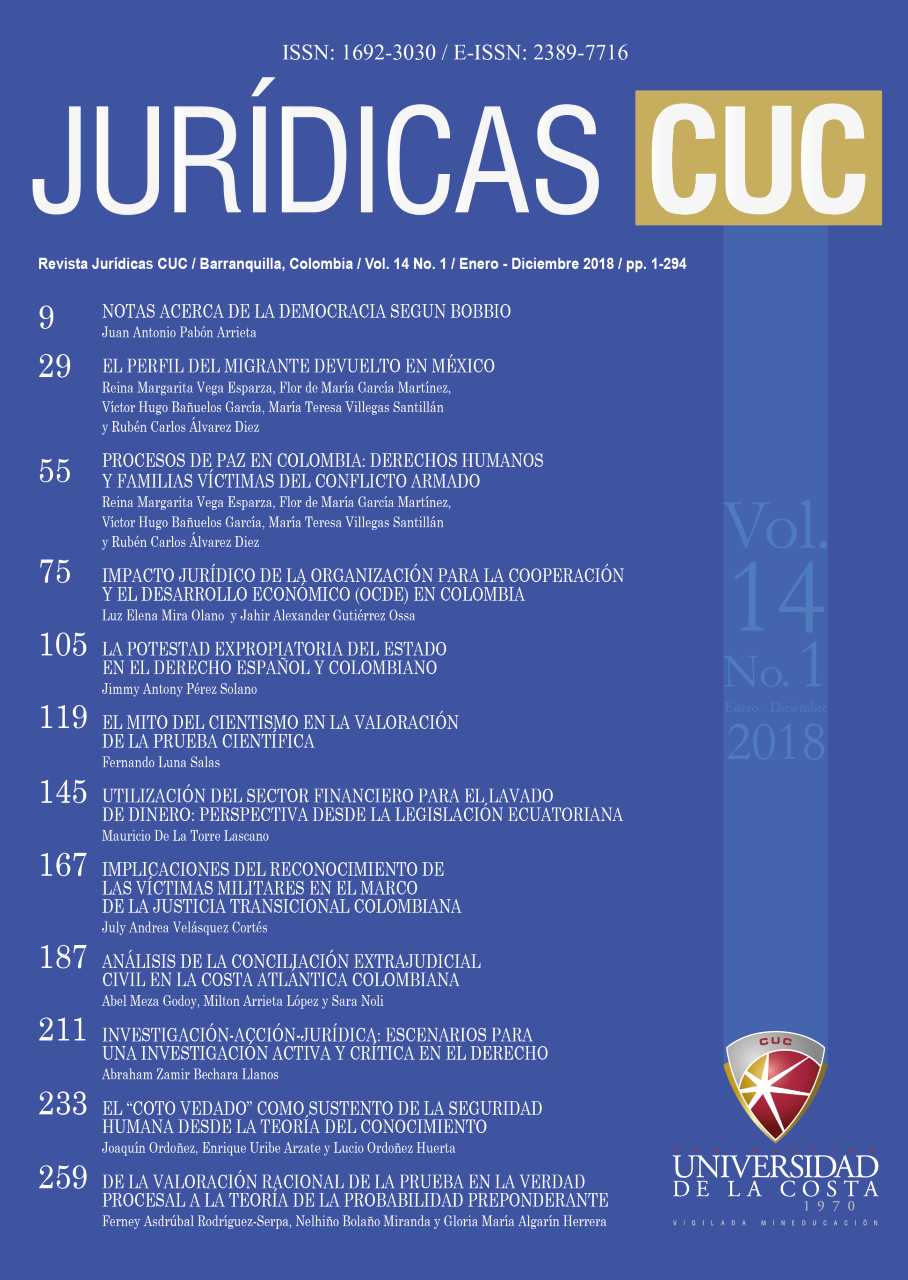The “prohibited limit” as a support for human security from the stance of the theory of knowledge
DOI:
https://doi.org/10.17981/juridcuc.14.1.2018.11Keywords:
prohibited limits, human security, heory of knowledgeAbstract
In this paper, the theory of the “prohibited limits” and the concept of “human security” are reviewed, and its main theoretical categories are analyzed in order to identify the existing relationship between both, as well as their differential and coincidental aspects. This review was made based on a documentary methodology from both an analytical and synthetic point of view. Theoretical aspects were considered to distinguish the close relationship between both categories, hence, allowing a better understanding of the social phenomenon of human insecurity. The findings show that there is a cognitive relationship between the properties of the prohibited limits and human security as objects of knowledge. In addition, the regularity in the relationships
between each of these objects and their properties were acknowledged, leading to the categories of causality and substantiality. The foregoing allows proposing the theory of the prohibited limits as source and sustenance of human security.
Keywords: prohibited limits, human security, theory of knowledge
Downloads
References
Ferrajoli, L. (2004). Derechos y garantías. La ley del más débil. (A. Ibañez y A. Greppi, trads.). Madrid: Trotta.
Fundación CIDOB. (2004). Seguridad humana: conceptos, experiencias y propuestas. Una doctrina de seguridad humana para Europa. Revista CIDOB d’afers internacionals, (76), p. 159-199.
Garzón, E. (1989). Algo más acerca del “coto vedado”. Doxa. Cuadernos de Filosofía del Derecho, (6), 209-213.
Garzón, E. (2000). Instituciones suicidas. Estudios de ética política.México, D.F.: Universidad Nacional Autónoma de México.
Garzón, E. (2005). El consenso democrático: fundamento y límites del papel de las minorías. Isonomía: revista de teoría y filosofía del derecho, (12), 7-34.
Hessen, J. (2007). Teoría del conocimiento. México, D.F.: Tomo.
Kay, S. (2006). Global security in the Twenty-first century. USA: Rowman & Littlefield Publishers Inc.
Krause, K. (2005). Seguridad humana: ¿ha alcanzado su momento?Revista Papeles de Cuestiones Internacionales, (9 0), 11-18.
Morillas, P. (2006). Génesis y evolución de la expresión de la seguri-dad humana. Un repaso histórico. Revista CIDOB d’Afairs In-ternacionals, (76). 47-58. Recuperado de https://www.raco.cat/index.php/RevistaCIDOB/article/view/55706/64992
ONU. (2005). Documento Final de la Cumbre 2005, [Resolución 60/1 de la Asamblea General]. Recuperado de https://www2.ohchr.org/spanish/bodies/hrcouncil/docs/gaa.res.60.1_sp.pdf
Programa de las Naciones Unidas para el Desarrollo, PNUD. (1994). Informe sobre el Desarrollo Humano. Nuevas Dimensiones de la Seguridad Humana. México, D.F.: FCE.
Rodríguez, J. (2005). La noción de “seguridad humana”: sus virtudes y sus peligros. Polis, Revista Latinoamericana, Centro de Investigación Sociedad y Políticas Públicas (CISPO), (11). 1-18
Rojas, F. (2007). Seguridad humana: aportes en la reformulación del concepto de seguridad. En: I. Sepúlveda Muñoz (coord.), Seguridad humana y nuevas políticas de defensa en Iberoamérica, pp. 49-74, Madrid: UNED.
Vergara, M. (2008). Bien común y algunas reflexiones sobre la seguridad humana. Revista Política y Estrategia, (109), 13-35.
Downloads
Published
How to Cite
Issue
Section
License
The authors are exclusively responsible for the published articles, which do not necessarily reflect the views of the editorial committee.
JURIDICAS CUC respects the moral rights of authors who have assigned the property rights on the published materials to the editorial committee. In turn, the authors declare that the work they submit has not been previously published.


 English
English
 Español (España)
Español (España)



